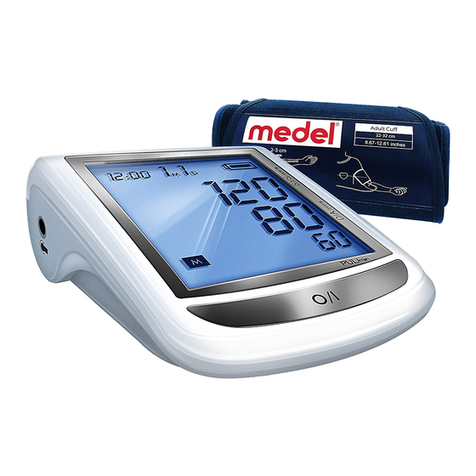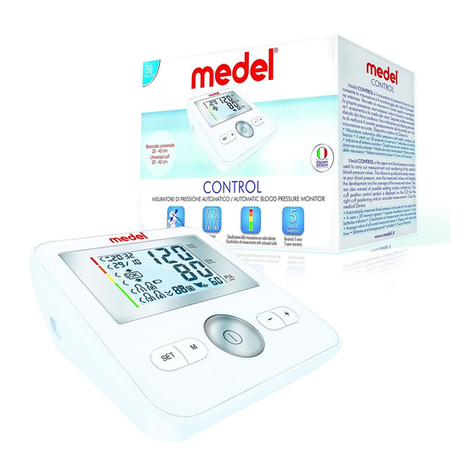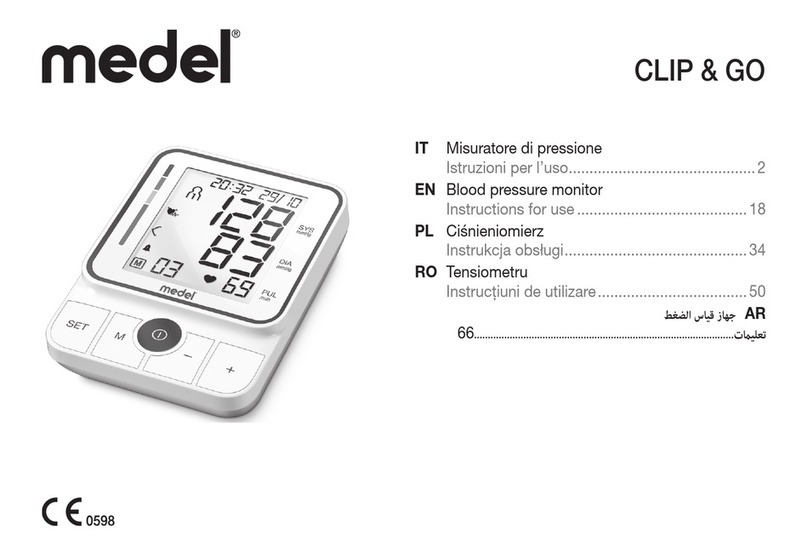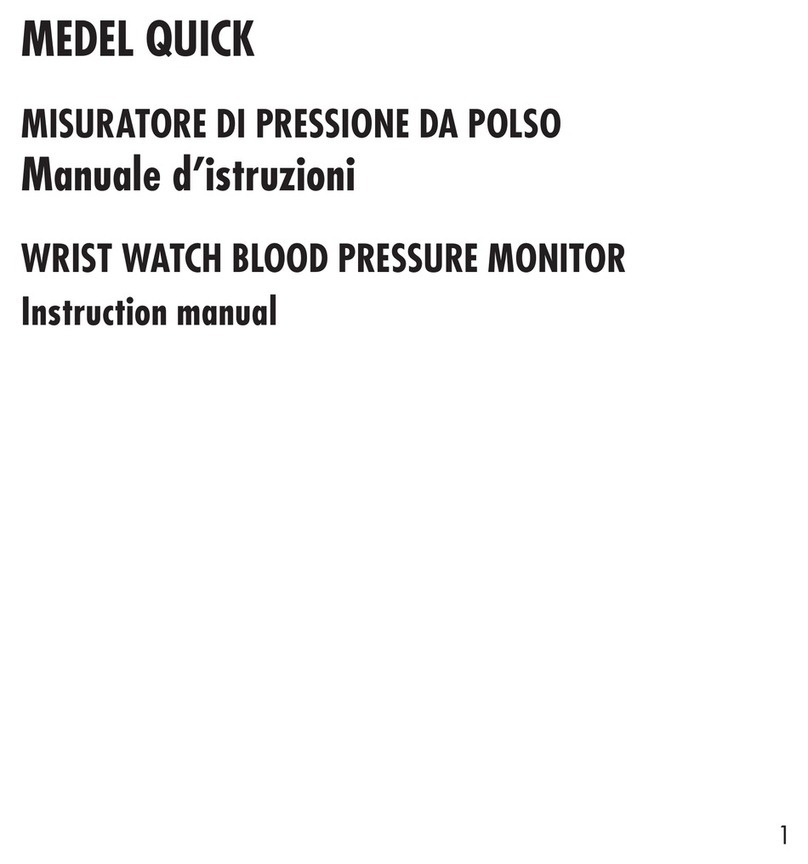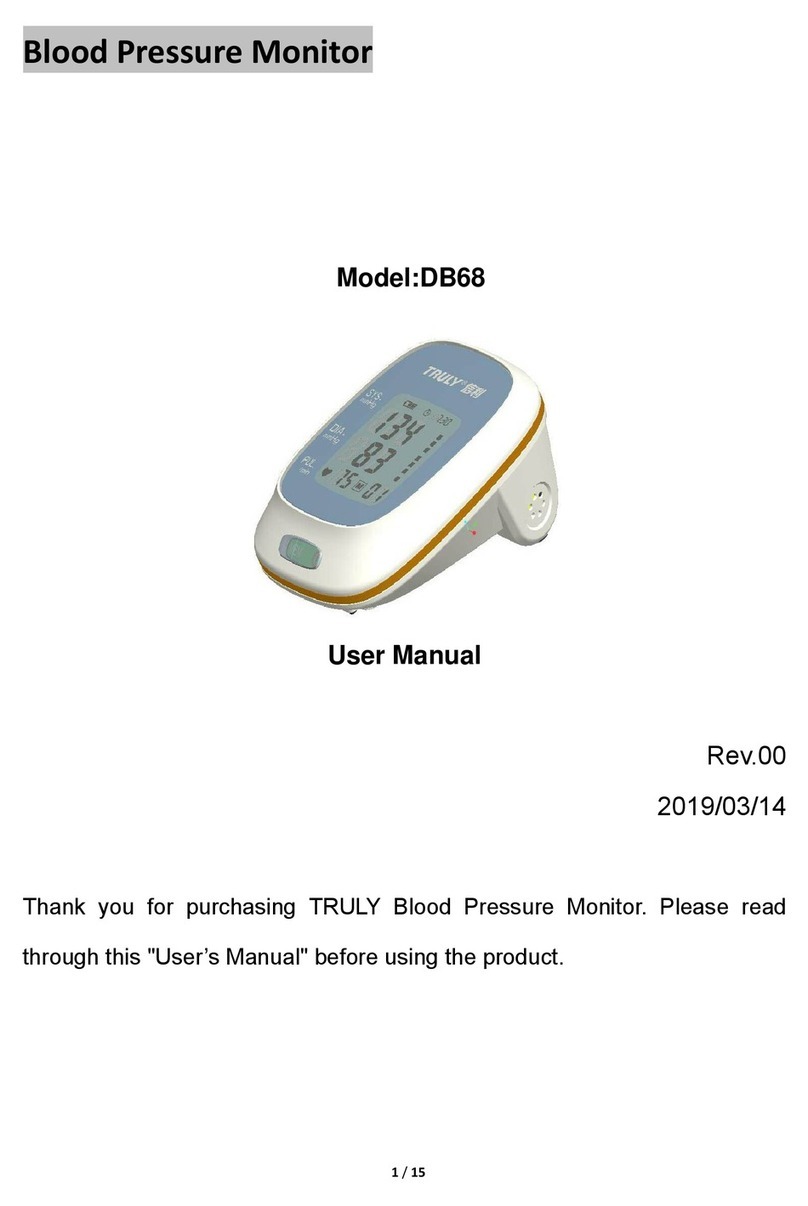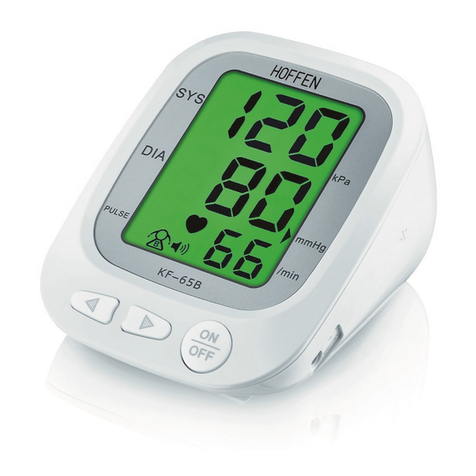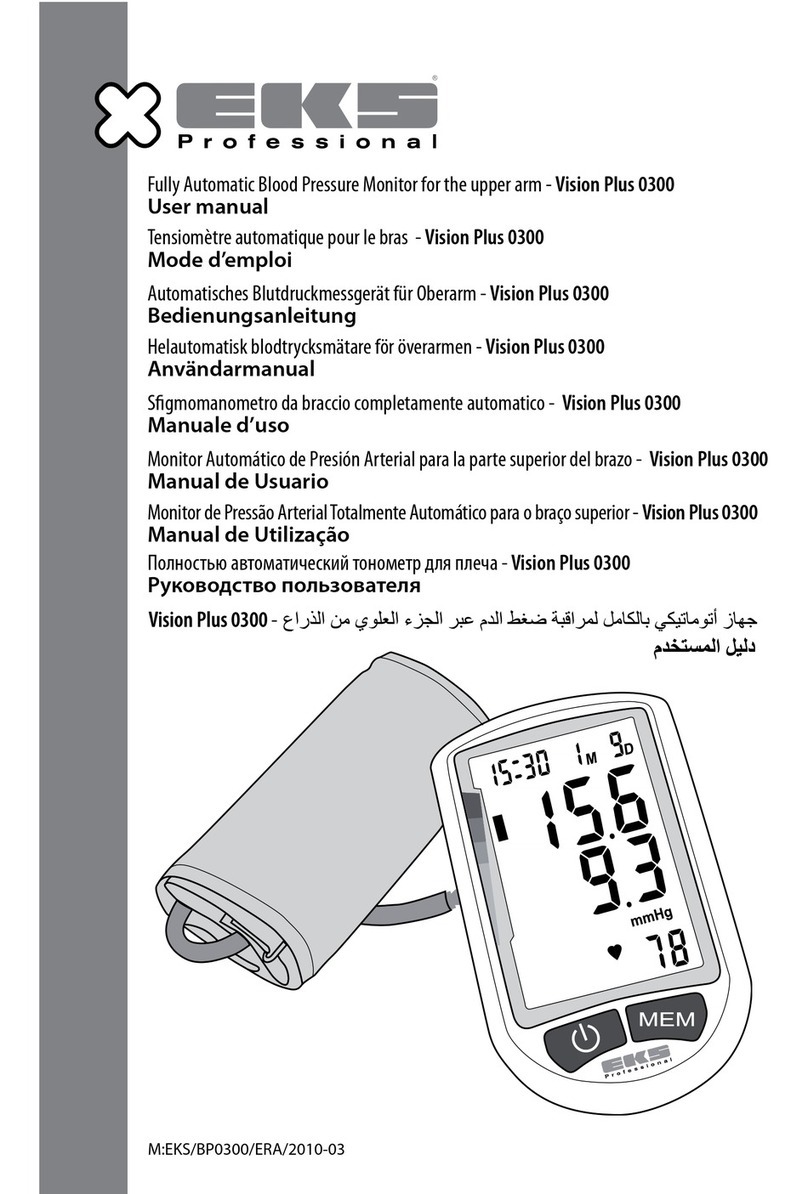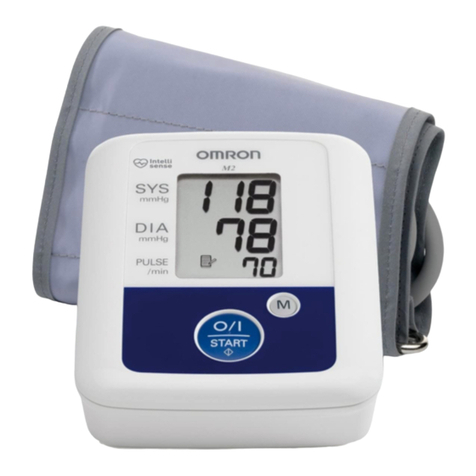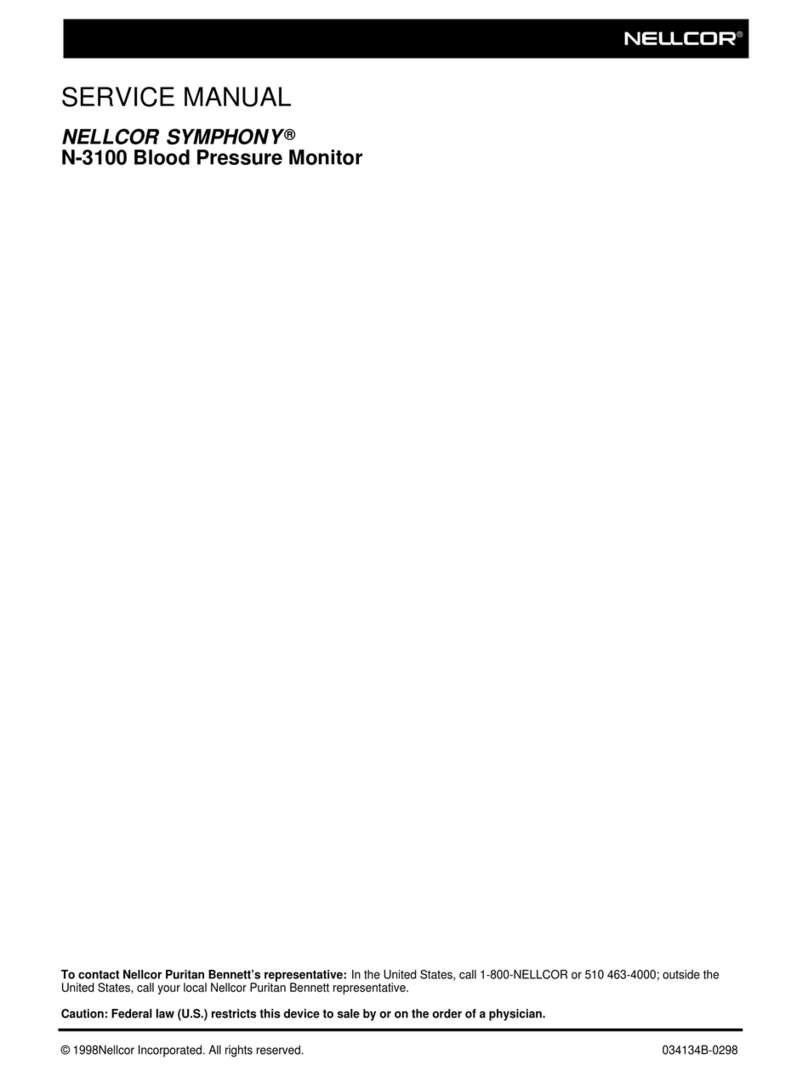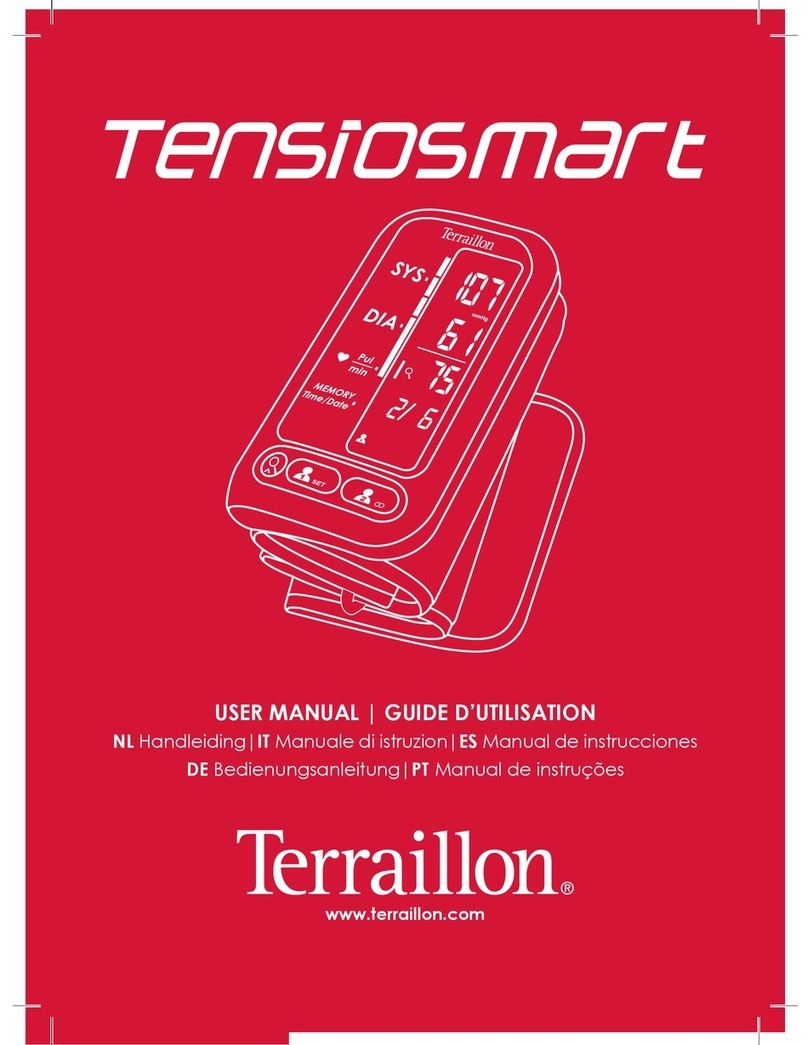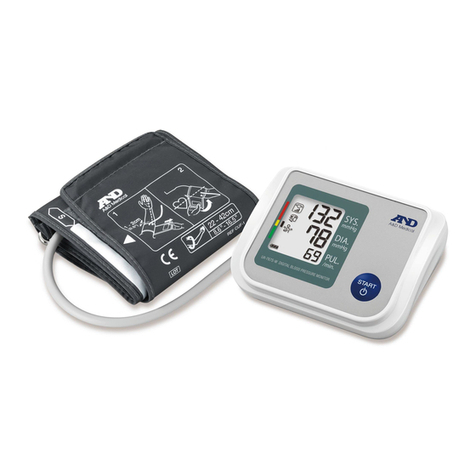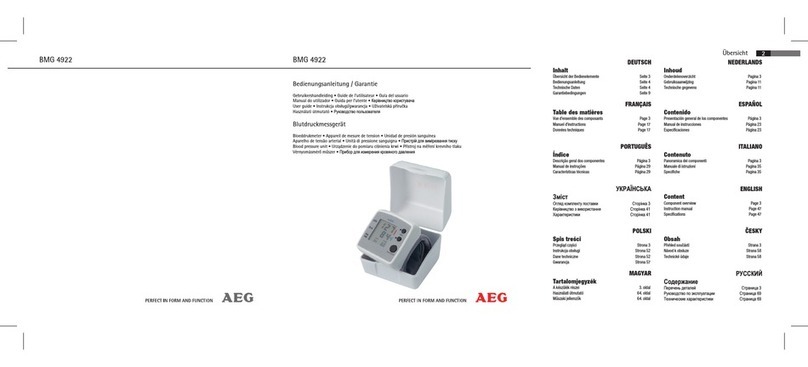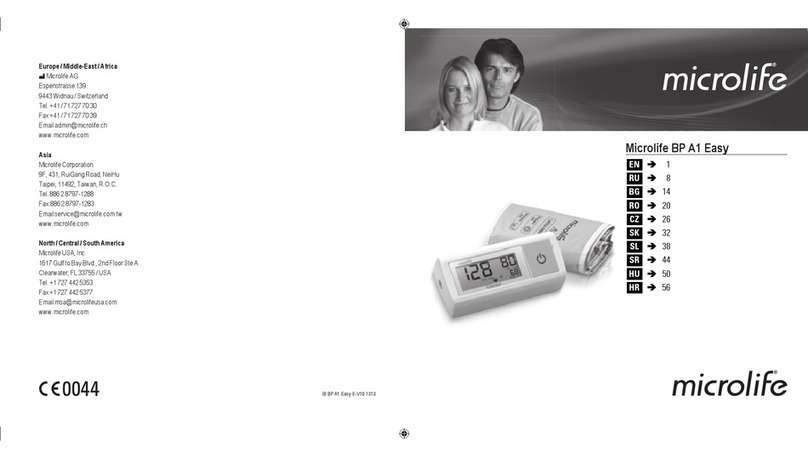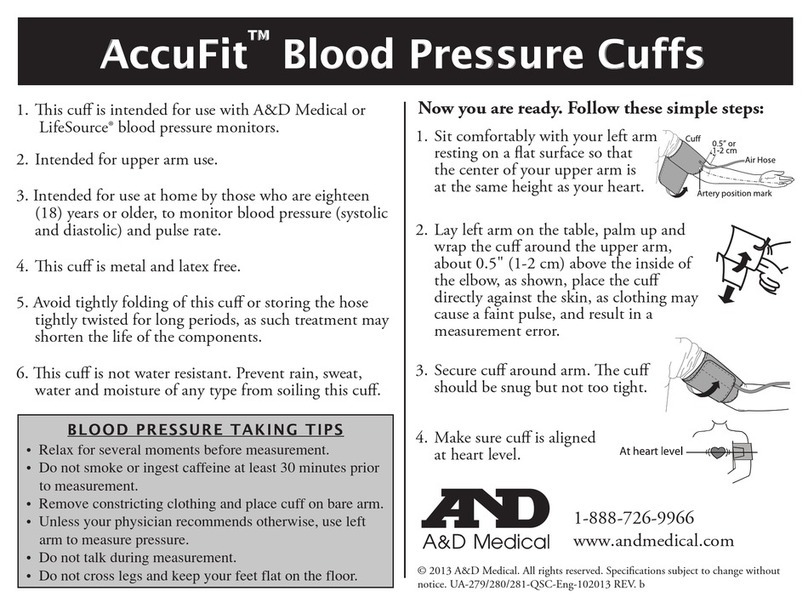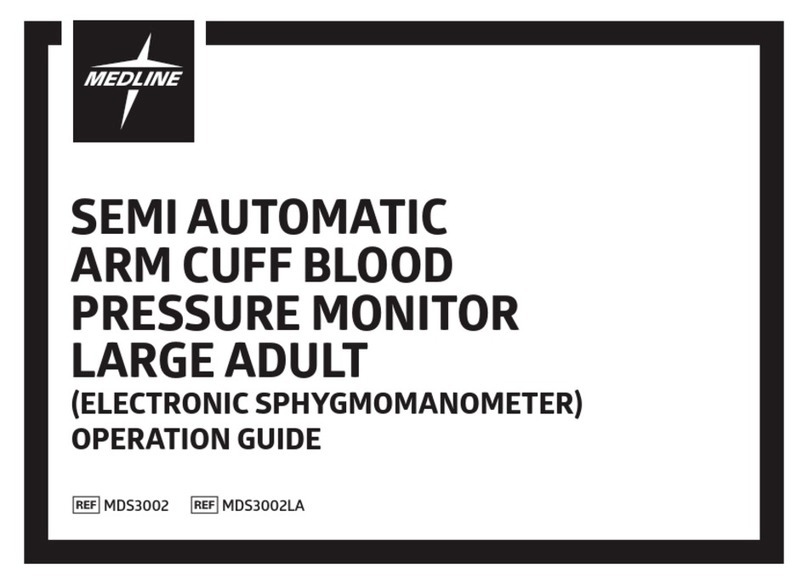Medel Check User manual


Professional Blood Pressure Monitor
Instruction manual
25
UK
manu MEDEL CHECK UK 25/48 24-03-2004 12:46 Pagina 25

1. INTRODUCTION
1.1. MEDEL CHECK Features
MEDEL CHECK is a fully automatic, digital blood pressure measuring device with
integrated Average mode - CHECK3 technology for use on the upper arm. MEDEL
CHECK enables very fast and reliable measurement of the systolic and diastolic
blood pressure as well your pulse by use of the oscillometric method.
Average mode - CHECK3 technology is a new type of concept for optimum relia-
bility in self-measurement of blood pressure.
MEDEL CHECK is easy to use and is proven in clinical studies to provide excellent
accuracy. This device is validated by a protocol (Protocol for the evaluation of
blood pressure measuring) created by the British Hypertension Society. MEDEL
CHECK has obtained, thanks to its accuracy, the highest evaluation level:
Systolic pressure - A Degree
Diastolic pressure - A Degree
Before using MEDEL CHECK, please read through this instruction manual
carefully and then keep it in a safe place. For further questions on the subject of
blood pressure and its measurement, please contact your doctor.
Attention!
1.2. Important information about check-measurement
• Do not forget: self-measurement means control, not diagnosis or treatment.
Unusual values must always be discussed with your doctor.
Under no circumstances should you alter the dosages of any drugs pre-
scribed by your doctor.
• The pulse display is not suitable for checking the frequency of heart pace-
makers!
• In cases of cardiac irregularity (Arrhythmia), measurements made with this
instrument should only be evaluated after consultation with the doctor.
27
UK
26
UK
Table of contents
1. INTRODUCTION 27
1.1. MEDEL CHECK features 27
1.2. Important information about self-measurement 27
2. IMPORTANT INFORMATION ON THE SUBJECT OF BLOOD-PRESSURE 28
AND ITS MEASUREMENT
2.1. How does high/low blood-pressure arise? 28
2.2. Which values are normal? 28
2.3. What can be done, if regular high/low values are obtained? 29
2.4. Average mode - CHECK3 technology 31
3. THE VARIOUS COMPONENTS OF THE BLOOD-PRESSURE MONITOR 33
4. PUTTING THE BLOOD-PRESSURE MONITOR INTO OPERATION 34
4.1. Inserting the batteries 34
4.2. Using a mains adapter 35
4.3. Tube connection 35
5. CARRYING OUT A MEASUREMENT 36
5.1. Before the measurement 36
5.2. Common sources of error 36
5.3. Fitting the cuff 37
5.4. Measurements mode selection 38
5.5. Measuring procedure 39
5.6. Discontinuing a measurement 40
5.7. Memory – displaying the last measurements 40
6. ERROR MESSAGES/MALFUNCTIONS 41
7. MAINTENANCE AND REPAIRS 43
8. CARE AND MAINTENANCE, RECALIBRATION 44
9. REFERENCE TO STANDARDS 45
10. TECHNICAL SPECIFICATIONS 46
11. WARRANTY 47
manu MEDEL CHECK UK 25/48 24-03-2004 12:46 Pagina 26

29
UK
28
UK
and/or diastolic values under 60mmHg, likewise, please consult your doctor.
Even with normal blood-pressure values, a regular self-check with your blood-pres-
sure monitor is recommended. In this way you can detect possible changes in your
values early and react appropriately.
If you are undergoing medical treatment to control your blood pressure, please
keep a record of the level of your blood pressure by carrying out regular self-mea-
surements at specific times of the day. Show these values to your doctor. Never use
the results of your measurements to alter independently the drug doses prescri-
bed by your doctor.
Table for classifying blood-pressure values (units mmHg):
Range Systolic Blood-pressure Diastolic Blood-pressure Measures
(maximum) (minimum)
Hypotension lower than 100 lower than 60 Check with your
doctor
Normal range between 100 and 140 between 60 and 90 Self-check
Mild hypertension between 140 and 160 between 90 and 100 Consult your doctor
Moderately serious between 160 and 180 between 100 and 110 Consult your doctor
hypertension
Serious hypertension higher than 140 higher than 110 Urgent!
See your doctor
Specific systolic higher than 140 lower than 90 Consult your doctor
hypertension
Further information
• If your values are mostly standard under resting conditions but exceptionally
high under conditions of physical or psychological stress, it is possible that
you are suffering from so-called ”labile hypertension”. Please consult your
doctor if you suspect that this might be the case.
• Correctly measured diastolic blood-pressure values above 120mmHg requi-
re immediate medical treatment.
Electromagnetic interference:
The device contains sensitive electronic components (Microcomputer). Therefore,
avoid strong electrical or electromagnetic fields in the direct vicinity of the device
(e.g. mobile telephones, microwave ovens). These can lead to temporary impair-
ment of the measuring accuracy.
2. IMPORTANT INFORMATION ON THE SUBJECT OF
BLOOD-PRESSURE AND ITS MEASUREMENT
2.1. How does high/low blood-pressure arise?
The level of blood-pressure is determined in a part of the brain, the so-called cir-
culatory centre, and adapted to the respective situation by way of feedback via the
nervous system.
To adjust the blood-pressure, the strength and frequency of the heart (Pulse), as well
as the width of circulatory blood vessels is altered. The latter is effected by way of
fine muscles in the blood-vessel walls.
The level of arterial blood-pressure changes periodically during the heart activity:
during the ‘blood ejection‘ (Systole) the value is maximal (systolic blood-pressure
value), at the end of the heart’s ‘rest period’ (Diastole) it is minimal (diastolic blood-
pressure value).
The blood-pressure values must lie within certain normal ranges in order to prevent
particular diseases.
2.2 Which values are normal?
Blood pressure is too high if at rest the systolic blood-pressure is over 160mmHg
and/or the diastolic blood-pressure is above 90mmHg. In this case, please consult
your doctor immediately. Long-term values at this level endanger your health due
to the associated advancing damage to the blood vessels in your body.
Should the systolic blood-pressure values lie between 140mmHg and 160mmHg
and/or the diastolic blood-pressure values lie between 90mmHg and 100mmHg, like-
wise, please consult your doctor. Furthermore, regular self-checks will be necessary.
With blood-pressure values that are too low, i.e. systolic values under 105mmHg
manu MEDEL CHECK UK 25/48 24-03-2004 12:46 Pagina 28

31
UK
30
UK
D) Physical constitution:
• After a preliminary medical examination, do regular sport.
• Choose sports which require stamina and avoid those which require strength.
• Avoid reaching the limit of your performance.
• With previous illnesses and/or an age of over 40 years, please consult your
doctor before beginning your sporting activities. He will advise you regar-
ding the type and extent of types of sport that are possible for you.
2.4. CHECK3 technology
• CHECK3 technology is a new type of concept for optimum reliability in self-
measurement of blood pressure.
• An advanced measurement accuracy is achieved by the automatic analysis
of three successive measurements.
• The new system provides reliable values for the doctor and can be used as
the basis for reliable diagnostics and medication therapy for high blood
pressure.
A) Why CHECK3 technology?
• Human blood pressure is not stable
• Scattering of devices
B) Key advantages
Reduction of:
• Device scattering
• Insufficient rest prior to measurement
• Movement artefacts
• Cuff positioning influences
C) Medical benefits
• Improved accuracy
• Reliable patient self-measurement data for the doctor
• Safe hypertension diagnostic
• Reliable therapy control
D) Measurement sequence
• First measurement
2.3. What can be done, if regular increased/low values are obtained?
a) Please consult your doctor.
b) Increased blood-pressure values (various forms of hypertension) are asso-
ciated long- and medium term with considerable risks to health. This con-
cerns the arterial blood vessels of your body, which are endangered due to
constriction caused by deposits in the vessel walls (Arteriosclerosis). A defi-
cient supply of blood to important organs (heart, brain, muscles) can be the
result. Furthermore, with long-term continuously increased blood-pressure
values, the heart will become structurally damaged.
c) There are many different causes of the appearance of high blood pressure.
We differentiate between the common primary (essential) hypertension, and
secondary hypertension. The latter group can be ascribed to specific orga-
nic malfunctions. Please consult your doctor for information about the possi-
ble origins of your own increased blood pressure values.
d) There are measures which you can take, not only for reducing a medically
established high blood pressure, but also for prevention. These measures are
part of your general way of life:
A) Eating habits
• Strive for a normal weight corresponding to your age. Reduce overweight!
• Avoid excessive consumption of common salt.
• Avoid fatty foods.
B) Previous illnesses
• Follow consistently any medical instructions for treating previous illness
such as:
- Diabetes (Diabetes mellitus)
- Fat metabolism disorder
- Gout
C) Habits
• Give up smoking completely.
• Drink only moderate amounts of alcohol.
• Restrict your caffeine consumption (Coffee).
manu MEDEL CHECK UK 25/48 24-03-2004 12:46 Pagina 30
Other manuals for Check
3
Table of contents
Other Medel Blood Pressure Monitor manuals

Medel
Medel Elite User manual
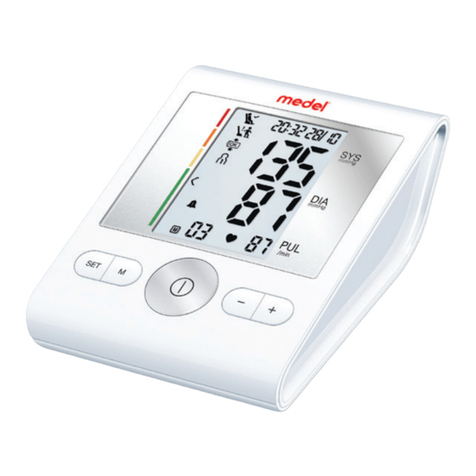
Medel
Medel GCE602 User manual
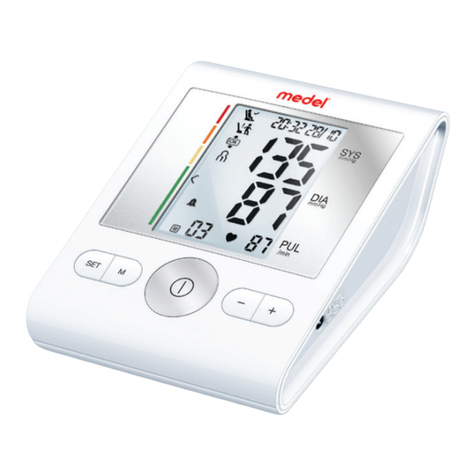
Medel
Medel GCE602 User manual
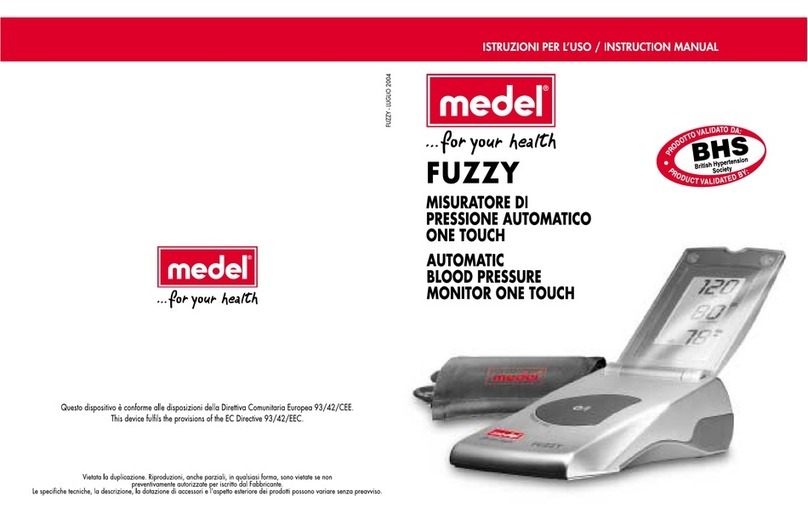
Medel
Medel FUZZY User manual
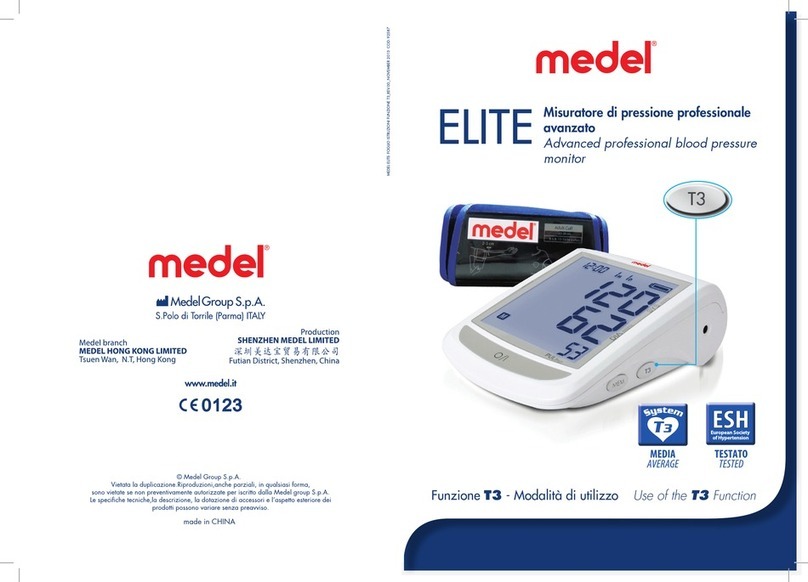
Medel
Medel Elite User manual
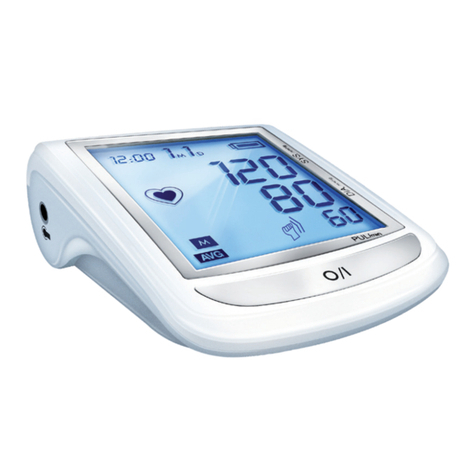
Medel
Medel ELITE 16897423 User manual
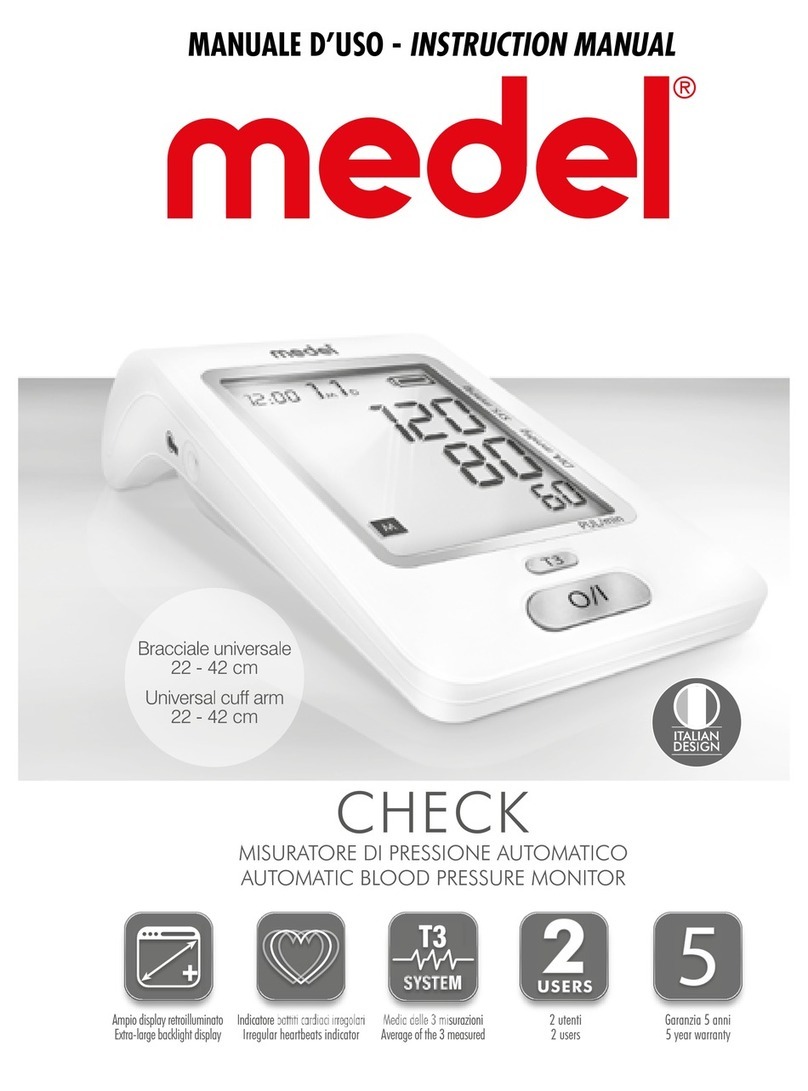
Medel
Medel Check User manual

Medel
Medel Check User manual
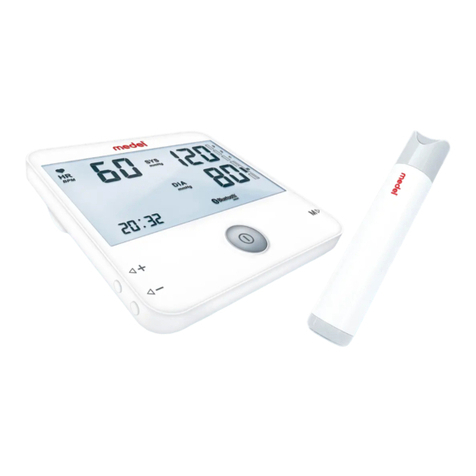
Medel
Medel Connect Cardio MB10 User manual
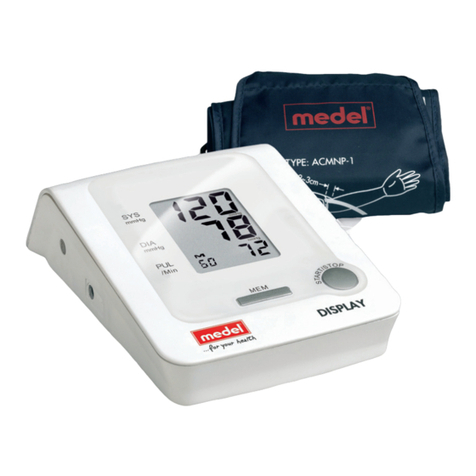
Medel
Medel ACMNP-1 User manual
